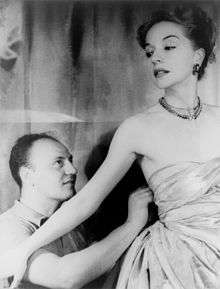Dressmaker
A dressmaker is a person who makes custom clothing for women, such as dresses, blouses, and evening gowns. A dressmaker is also called a mantua-maker (historically), modiste, or fabrician.

Notable dressmakers
- Cristóbal Balenciaga
- Pierre Balmain
- Coco Chanel
- Christian Dior
- David Emanuel
- Jean Muir, fashion designer (though she herself preferred to be called a dressmaker[1])
- Anna and Laura Tirocchi, Providence, Rhode Island
- Isabel Toledo
- Madeleine Vionnet
- Charles Frederick Worth
- Elizabeth Keckley, modiste and confidante to Mary Todd Lincoln
- Janet Walker, costumier and dress making bust inventor
- Madame Palmyre, a favorite designer and dressmaker of the empress of France, Eugénie de Montijo[2]
Related terms

Jean-Baptiste Jules Trayer, Breton seamstresses in a shop 1854). Prior to the Industrial Revolution, a seamstress did handsewing.
- Dressmaker denotes clothing made in the style of a dressmaker, frequently in the term dressmaker details which includes ruffles, frills, ribbon or braid trim. Dressmaker in this sense is contrasted to tailored and has fallen out of use since the rise of casual wear in the mid-twentieth century.
- Mantua-maker, in the eighteenth century a maker of mantuas, or in general a dressmaker.
- Modiste, a maker of fashionable clothing and accessories, with the implication that the articles made reflect the current Paris fashions.
- Fabrician, a person who is considered an expert in making modifications and alterations to fabrics and other articles of clothing. Similar to magicians, fabricians are experts in the art of coercion, specifically with fabric.
- Sewing professional is the most general term for those who make their living by sewing, teaching, writing about sewing, or retailing sewing supplies. A sewing professional may work out of the home, a studio, or retail shop, and may work part-time or full-time. This work may include any or all of the following sub-specialities:
- A custom clothier makes custom garments one at a time, to order, to meet an individual customer's needs and preferences.
- A custom dressmaker specializes in women's custom apparel, including day dresses, careerwear, suits, evening or bridal wear, sportswear, or lingerie.
- A tailor makes custom menswear-style jackets and the skirts or trousers that go with them, for men or women.
- An alterations specialist or alterationist adjusts the fit of completed garments, usually ready-to-wear, or restyles them. Note that while all tailors can do alterations, by no means can all alterationists do tailoring.
- Designers choose combinations of line, proportion, color, and texture for intended garments. They may have no sewing or patternmaking skills, and may only sketch or conceptualize garments.
- Patternmakers flat draft the shapes and sizes of the numerous pieces of a garment by hand using paper and measuring tools or by computer using CAD software, or by draping muslin on a dressform.
- A wardrobe consultant or fashion advisor recommends styles and colors for a client.
- A seamstress is a woman who sews, especially one who earns a living by sewing. Prior to the Industrial Revolution, a seamstress did handsewing, especially under the putting-out system. Older variants are seamster and sempstress.
- Sewist is a relatively new term, combining the words "sew" and "artist", to describe someone who creates sewn works of art, which can include clothing or other items made with sewn elements.
gollark: Allegedly.
gollark: And why aren't diacritics used more?
gollark: And why is there no good namespacing?
gollark: Indeed.
gollark: Why is sin^2(x) (sin x)^2 but sin^-1 the inverse?
See also
References
- Liz Jones for The Daily Mail, 12 June 2006
- Valerie Steele: Women of Fashion: Twentieth-century Designers, Rizzoli International, 1991
| Wikimedia Commons has media related to Dressmaking. |
- Butterick Publishing Company: "The Art of Garment Cutting, Fitting and Making", 1894.
- Deckert, Barbara: Sewing for Plus Sizes: Design, Fit and Construction for Ample Apparel, Taunton, 1999, Appendix B: How to Find, Select, and Work With a Custom Clothier, pp. 142-143.
- Kirke, Betty: "Madeleine Vionnet", Chronicle Books, 1998.
- Picken, Mary Brooks: The Fashion Dictionary, Funk and Wagnalls, 1957.
This article is issued from Wikipedia. The text is licensed under Creative Commons - Attribution - Sharealike. Additional terms may apply for the media files.